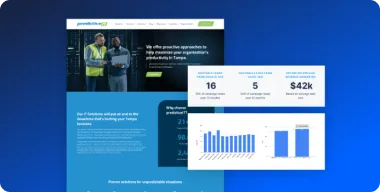Marketing as a manufacturer isn’t as simple as following the best practices printed in so many articles on the subject. Your audience is unique. Your sales process is longer. Your services are highly customized and frequently rather costly.
Because of these factors, you need to know whether your investment is really working beyond social media likes and shares.
Let’s take a closer look at five KPIs you should be tracking and what they represent for your business and its marketing strategy.
Website Traffic
While not directly indicative of whether your marketing efforts are working or not, website traffic is a metric that directly impacts so many others. Specifically, you need to know:
The trend line of traffic to your website over time – are more people visiting? If not, why?
The specific sources of traffic to your website. If there is a strong referral source or if you are performing well in a specific social channel, what actions are taken to drive those visits?
How the traffic growth and sources correlate to some of the other metrics we’re about to look at.
Traffic is not the most important metric for a marketing campaign, but without it, nothing else happens, so it needs to be at the top of your list.
Page Performance
One of the reasons traffic alone isn’t a good metric is that visits are not created equal. Someone might visit your website, leave half a second later and never engage with any of your content. Another visitor might spend 2 hours on your site reading everything you’ve ever written as they research your services. For this reason, we look at page performance metrics such as:
- Time on Site – How much time does the average visitor spend on the website? This number should be close to or above 2 minutes.
- Bounce Rate – This is the percentage of people who leave the site before engaging with any content. A good average is 55% or lower.
- Pages Viewed – How many pages does someone view in a single visit? A good low number is 2, but this will vary depending on the number of pages on your site and how they are structured.
With this data, you can get a better sense of traffic quality. If traffic is up 10%, but your time on site is down by 20%, are you really getting more of the right eyeballs on your content?
Search Engine Performance
The single most valuable source of traffic to your website is from search engines. Organic search traffic represents people looking for the answer to a question and finding your site.
It tends to convert at a higher rate and provide better quality (at a lower relative cost) than other sources, so we spend more time looking at it than any others. Specifically, you should measure:
- Keyword Rankings – How are your target keywords ranked in search engines? Are you getting traffic for the things that you offer? Are there oddball keywords driving a lot of traffic that has lower value?
- Click Thru Rate – Are you getting the amount of traffic you should based on your rankings? You can see traffic estimates in tools like MOZ and Ahrefs.com. If you are severely underperforming estimates, it could be a sign of low quality page titles and META descriptions.
- Total Organic Traffic – Is your volume of organic traffic increasing over time. Tracking this number is important because you want to see a steady, consistent increase over time. Sharp drops can be a sign of penalties against your site, while sharp rises should be monetized as much as possible.
Conversion Metrics
So far, we’ve only discussed metrics related to getting people on your website. Now come the ones your boss will really care about – conversions.
How much of the traffic you generate is converting to new leads on your site and where are they converting?
- Click Thru Rates – The CTR of your calls-to-action is incredibly important, showing how many people are interested in your offer and willing to learn more. Low CTA CTR can indicate poor UX, low value content, or a lack of conversion points on a given page. Aim for 3-4% minimum for this number.
- Landing Page Conversions – Once someone clicks a CTA, how often do they convert to a new contact? The bare minimum conversion rate for a landing page should be 2%, but the actual target will vary depending on the stage of the marketing funnel it represents. An eBook or white paper about an interesting topic should convert at 15% or higher, while your basic Contact Us page will be between 2-5% on average.
- Overall Site Conversion Rate – By multiplying CTR and Landing Page Conversion rates, you can determine what percentage of people who visit your site become new contacts. This number should be at least 1% and upwards of 3% from highly relevant traffic sources. Keep track of how each traffic source performs as well so you can measure ROI from your efforts.
Qualified Leads and Customers
Finally, we come to the KPI that matters most – sales.
If this is so important, why is it last in the list? Because it’s impossible to fully understand your ultimate conversion rates if you don’t first understand where your traffic comes from, which pages are represented, and how people engage with your calls-to-action and landing pages.
Companies will frequently see a good number here and ignore the rest, leaving a lot of growth potential on the table. Others will see a bad number and end investment when the marketing mix has some potential to it.
- Marketing Qualified Leads – Of the people who convert on your site, how many are moved to a stage of qualification based on action. Marketing qualified leads (MQLs) are those who actively engage with follow-up emails, respond to inquiries, and show interest in a further conversation. This is the base “quality lead” metric – how many of the leads generated are any good.
- Sales Qualified Leads – For most marketers, this is the goal. Getting a prospect into the hands of the sales team. For our purposes, it’s not the end, but it does represent a big jump in value. If your average close rate is 25%, you can guarantee a new customer out of every 4 SQLs.
- Customer Conversion Rate – Finally, how many customers do you generate from your marketing efforts overall? This is where ROI comes into play, and by understanding the rest of the metrics listed above, you can get a sense of what works and what doesn’t.
By tracking the 5 KPIs in this article, and the specific metrics they are comprised of, you can get a holistic sense of what works, what doesn’t, and where to invest both time and budget for your marketing efforts over time.
For any manufacturer, this is the most important way to ensure you aren’t pouring money down the drain and that your digital efforts are as effective as you keep reading they can be.
[scorg_shortcode id=”86092″]






